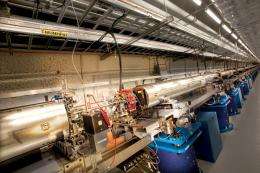First Pump-Probe Experiment at Linac Coherent Light Source Completed

(PhysOrg.com) -- The first experiment using the Linac Coherent Light Source to illuminate molecules via a "pump-probe" technique has been completed by an international team of more than 30 scientists from institutions including Lawrence Berkeley National Laboratory, LCLS and the joint SLAC/Stanford PULSE Institute. Ryan Coffee, physicist with the LCLS Laser Group, presented initial results in a seminar at SLAC on Wednesday, November 18.
Pump-probe experiments use one laser pulse, in this case an infrared pulse, to pump energy into a sample and then probe it with another laser pulse, in this case an LCLS X-ray pulse. Such experiments are ideal for looking at atomic and molecular interactions, which take place in tiny fractions of a second. The LCLS probe pulses were as short as a few quadrillionths of a second and a billion times brighter than any X-ray source produced in a laboratory.
Coffee and his colleagues looked at the quantum behavior of electrons in nitrogen molecules, N2. The results represent a step toward a fundamental understanding of how nature converts light into chemical energy and might one day help revolutionize solar power, Coffee said.
Nitrogen atoms distribute their electrons between a lower and a higher energy shell. Using X-rays, the team picked off two electrons from the lower level, allowing a higher shell electron to descend and fill the vacancy. The energy released during this downward plunge ejected another electron from the atom, a phenomenon known as the Auger effect.
The team wanted to study how the nitrogen molecules' orientation affected this reaction. To do this, they used the infrared laser to line up the nitrogen molecules so that they were all facing the same direction.
"In a sense, we tried to make the gas act a little bit like a crystal," Coffee said.
After hitting the nitrogen with X-rays, the researchers detected electrons flying off and measured how the molecules' alignment with respect to the X-rays influenced the Auger effect. They observed numerous features that had strong dependence on the molecules’ direction. The results are currently being prepared for publication.
Future work will focus on how atomic bonds change as molecules either break apart or rearrange. Coffee thinks such work will lead to a deeper understanding of how nature converts light into energy. Ultimately, he hopes the results will lead to technology that will help humans generate power from the sun.
"I'm going for the solar power revolution, though I don't know where it will come from," he said. His gut feeling is that the important atoms to look at are carbon, nitrogen and oxygen.
"That's where energy in nature comes from," he said.
Coffee added that the team owes a debt of gratitude to the LCLS Controls, Accelerator, and Laser Groups, who made the experiment's success possible.
Provided by SLAC National Accelerator Laboratory (news : web)





















